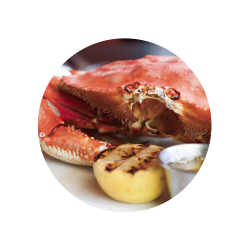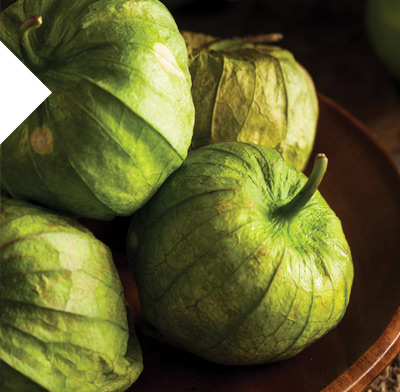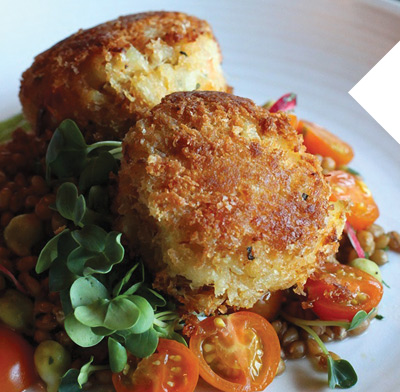In the mid-Atlantic home of the Chesapeake and Delaware bays where I grew up, everyone feasted on blue crabs boiled with loads of Old Bay spice. In fact, my very first restaurant job was making crab cakes – with blue crab – at the Hotel du Pont in Wilmington, Delaware.
After moving to Seattle at the age of 19, I discovered for the first time the local delight of sweet, briny, meaty Dungeness that are three- to four-pound monsters compared to those small, Atlantic blue crabs. To my surprise, I couldn’t find crab cakes on a single Seattle restaurant menu at that time. Well, I fixed that and put fresh Dungeness crab cakes on my Café Sport menu where they became an instant hit. Thousands of crab cakes and 35 years later, at Etta’s and Dahlia Lounge, we’re still selling those crusty, golden-brown cakes filled with pristine Dungeness crab with plenty of chunks of claw and leg meat. Here I offer a few of my crab cake making tips to the do-it-yourself types and those who are cruising further afield.

Crabmeat:
The most important thing is to use crabmeat that’s best and freshest in your area. Here in Seattle we make our crab cakes from Dungeness, using the body, leg, and claw meat.
Draining and Squeezing Crabmeat:
Dungeness tends to be wet. Before you make crab cakes, drain the crabmeat in a sieve. Gently squeeze the crabmeat with your hands to remove excess liquid and at the same time feel for any bits of cartilage or shell and remove them. Don’t go overboard squeezing your crabmeat because you don’t want to squeeze out all the flavor or make it too dry.
Mixing and Handling:
Mix gently. Crabmeat is graded and priced on the size of the lumps. It’s a treat to find some nice, intact lumps of crab meat inside your crab cake, and you don’t want to smash them up by over-mixing. Fold the crabmeat and the dressing together with a rubber spatula as if you’re folding whipped cream into a mousse.
Salt:
Some Dungeness is very salty. Taste your crabmeat first and adjust the salt in the recipe accordingly.
Chilling Crab Cakes:
Once shaped, most crab cakes will be easier to handle if you chill them before cooking. You can put them in the refrigerator, leaving them right in the pan of crumbs and covered with plastic wrap for at least 30 minutes or for several hours or even overnight. Another idea is to refrigerate the crab mixture first, then scoop and crumb the cakes right before you cook them.
Forming Crab Cakes:
A two-ounce ice cream scoop with a release lever is the perfect tool for shaping a classic two-and-a-half- to three-ounce cake. Lightly pack the scoop with the heel of your hand and release the cake directly into the pan of bread crumbs. Press the crumbs around the cake while you’re shaping it into a disc.
Cooking Crab Cakes:
 The easiest way to tell if a crab cake is cooked and hot all the way through is with an instant-read thermometer. Insert the thermometer into the center of the cake and if the temperature reads 145°F, you know your crab cake is fully cooked. Turn the crab cakes only once while cooking. Flip flopping them is likely to break them apart and you won’t get a nice crust. When you cook the crab cakes, use a good, seasoned cast-iron pan, a shiny stainless steel sauté pan such as an All-Clad or a KitchenAid, or a pan with a nonstick surface.
The easiest way to tell if a crab cake is cooked and hot all the way through is with an instant-read thermometer. Insert the thermometer into the center of the cake and if the temperature reads 145°F, you know your crab cake is fully cooked. Turn the crab cakes only once while cooking. Flip flopping them is likely to break them apart and you won’t get a nice crust. When you cook the crab cakes, use a good, seasoned cast-iron pan, a shiny stainless steel sauté pan such as an All-Clad or a KitchenAid, or a pan with a nonstick surface.

|
Herb Marinated and Grilled Flank SteakFrom I Love Crab Cakes by Tom Douglas (Morrow, 2006). Yields 2/3 cup.
Put the tomatillos in the bowl of a food processor and process until coarsely pureed. Remove the tomatillo puree to a sieve, drain off the liquid, and discard. Put the drained puree in a bowl and stir in the vinegar, sugar, green Tabasco, garlic, mustard seeds, and horseradish. Note: To toast spices, place them in a small heavy skillet over medium heat for a few minutes, shaking or stirring constantly, just until they are lightly browned and aromatic. |
Dungeness Crab CakesAdapted from I Love Crab Cakes by Tom Douglas (Morrow, 2006). Makes 8 crab cakes (serves four to eight depending on whether you serve one crab cake or two)
To make the crab cakes, put the crabmeat, mayonnaise, lemon zest, scallions, salt, and pepper in a large bowl. Mix everything together gently with a rubber spatula. Add the half-cup of panko and mix again. Pour the remaining two cups of panko into a shallow container. Form the crab mixture into eight patties. Pat them gently into shape without pressing them too much. Drop the patties into the panko and turn them to coat both sides, patting to shake off the excess. If you have time, you can let the crab cakes chill in the refrigerator an hour or more before frying. When you are ready to fry the crab cakes, preheat the oven to 450°F. Put two large non-stick skillets over medium-high heat and add about two and a half tablespoons of butter to each pan. As soon as the butter is melted, add four crab cakes to each pan. Leave the pans on the burners for a minute or slightly less (the butter should not be starting to brown), then place the pans in the oven. Cook the crab cakes until they are heated through and golden brown on both sides, about 12 minutes, carefully turning them with a spatula about halfway through the cooking time. Remove the pans from the oven and transfer the crab cakes to plates. Serve with the green cocktail sauce and lemon wedges. Note: Panko or Japanese bread crumbs are coarser than ordinary bread crumbs and stay nice and crisp when fried. Panko can be found in Japanese fish markets and in many large supermarkets. |

|

Q: What is special about food in the Pacific Northwest?
As a chef, I love to get creative with flavors and textures, but I can’t make anything better than the ingredients I start with. What’s special about the Pacific Northwest is the bounty provided by our farmers and foragers, our winemakers and cheesemakers, and especially the bounty that comes from our fisherpeople and shellfish farmers. We live in an extraordinary part of the world for access to oysters, mussels, wild salmon, Dungeness crab, and other treasures harvested and fished from Puget Sound and the Pacific Ocean.
Q: What is on the horizon for you in terms of restaurants, projects, culinary adventures, etc?
We’re excited about teaching people how to use these natural ingredients at Hot Stove Society, our new cooking school located inside the Hotel Ändra in downtown Seattle. It has been an eye-opener how interested people are in the natural bounty of our region and how eager they are to learn how to cook with it like a pro.
Q: How do you think the boating lifestyle and a passion for food go hand-in-hand?
The conviviality of being with family and friends while gazing out on the gorgeous waterways of this region- that’s just a natural for enjoyment of all the good things in life- and that includes delicious foods and delicious wines.
For readers wanting the bona fide original Seattle-style crab cakes, Tom Douglas’ Dahlia Lounge and Etta’s restaurants serve fresh Dungeness crab cakes at both lunch and dinner.
Dahlia Lounge: 2001 4th Ave, Seattle, WA 206 682 4142
Etta’s: 2020 Western Ave, Seattle, WA 206 443 6000